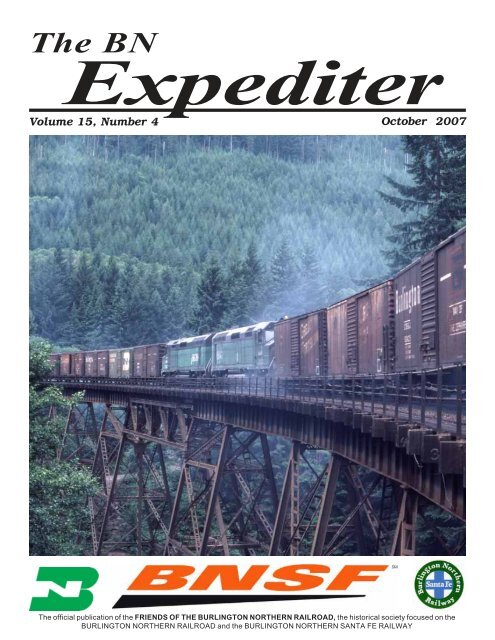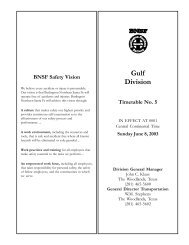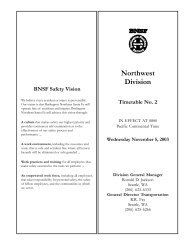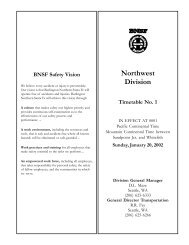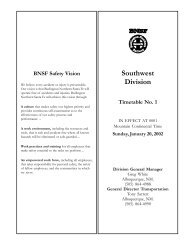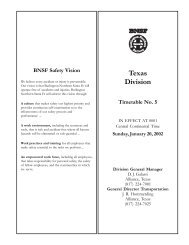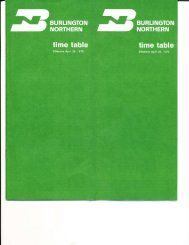Here - Friends of the Burlington Northern Railroad
Here - Friends of the Burlington Northern Railroad
Here - Friends of the Burlington Northern Railroad
Create successful ePaper yourself
Turn your PDF publications into a flip-book with our unique Google optimized e-Paper software.
(top) October 31, 1979helpers 1772/849/1795 areat <strong>the</strong> west end <strong>of</strong>Skykomish.(center) November 15, 1979#88 at Berne with <strong>the</strong> 6905/1791 for helpers.(bottom) June 25, 1979 train#88 exits Cascade Tunnelwith helpers 6900 & 6399.Page 2BN Expediter
<strong>Friends</strong> <strong>of</strong> <strong>the</strong><strong>Burlington</strong> Nor<strong>the</strong>rn<strong>Railroad</strong>PO Box 271, West Bend, WI 53095-0271www.fobnr.orgA Not-For-Pr<strong>of</strong>it CorporationRegistered in <strong>the</strong> State <strong>of</strong> IdahoThe <strong>Friends</strong> <strong>of</strong> <strong>the</strong> <strong>Burlington</strong> Nor<strong>the</strong>rn <strong>Railroad</strong> was formed toga<strong>the</strong>r, preserve and share information about <strong>the</strong> history andcurrent operations <strong>of</strong> <strong>the</strong> <strong>Burlington</strong> Nor<strong>the</strong>rn <strong>Railroad</strong>. It follows <strong>the</strong>development <strong>of</strong> <strong>the</strong> railroad from its inception in 1970 as <strong>the</strong> merger<strong>of</strong> <strong>the</strong> Great Nor<strong>the</strong>rn, Nor<strong>the</strong>rn Pacific, Chicago, <strong>Burlington</strong> andQuincy and <strong>the</strong> Spokane, Portland & Seattle <strong>Railroad</strong>s, up to <strong>the</strong>present and into <strong>the</strong> future.DirectorsJohn Adams, MD, John McKenzie, Kent Charles,David Poplawski, Gary SeymourOfficersPresident.......................Dave PoplawskiVice President........................John Adams, MDSecretary............................Gary SeymourTreasurer............................Jeff HendricksEditorKristopher JohnsonRegular membership is $25.00/year; Substaining membership is$50.00/year; Junior membership (16 and under) is $10.00/year.The Membership year is from January 1 to December 31. Send astamped, self-addressed envelope to <strong>the</strong> address above for moreinformation.The FOBNR is not supported by, nor affiliated in any way with, <strong>the</strong> <strong>Burlington</strong>Nor<strong>the</strong>rn Santa Fe Railway Co., its subsidiaries or affiliates.The BN ExpediterThe BN Expediter is published four times ayear and is included with membership in <strong>the</strong><strong>Friends</strong> <strong>of</strong> <strong>the</strong> <strong>Burlington</strong> Nor<strong>the</strong>rn <strong>Railroad</strong>.Manuscripts, photographs and information arewelcomed for publication. Materials are submittedwith <strong>the</strong> understanding that no monetary compensationwill be paid upon publication. Itemswill be returned only if requested. O<strong>the</strong>rwise <strong>the</strong>ywill go into <strong>the</strong> archives.Anything published in The BN Expediter (including<strong>the</strong> classifieds), must be focused on <strong>the</strong><strong>Burlington</strong> Nor<strong>the</strong>rn <strong>Railroad</strong>, from <strong>the</strong> 1970merger on. Information and/or pictures that givehistorical perspective or context are acceptable(e.g., pre-merger road numbers). The disposition<strong>of</strong> a locomotive, o<strong>the</strong>r piece <strong>of</strong> equipment orproperty is also acceptable. Fur<strong>the</strong>r informationis available from <strong>the</strong> Editor.Send material for publication to:The BN ExpediterPO Box 898Duvall, WA 98019-0898kristopherandlori@msn.comCopyright 2007 by <strong>the</strong> <strong>Friends</strong> <strong>of</strong> <strong>the</strong> <strong>Burlington</strong>Nor<strong>the</strong>rn <strong>Railroad</strong>. All rights reserved.BN ExpediterNewMembers<strong>Friends</strong> <strong>of</strong> <strong>the</strong> <strong>Burlington</strong> Nor<strong>the</strong>rn RRPO Box 271West Bend, WI 53095-0271www.fobnr.orgA. Michael Booth (07-015)8800 Well LoopBismarck, ND 58503Patrick Egan (07-016)5352 S. NevaChicago, IL 60638-1027Front CoverOn July 9, 1983, F45 6641 and 6636 help train#129 over Stevens Pass. Clouds <strong>of</strong> smoke from<strong>the</strong> brake shoes were a common sight on trainsdescending <strong>the</strong> hill.<strong>Here</strong> <strong>the</strong> helpers are crossing <strong>the</strong> Foss Riverbridge at MP 1728.2-Brian Ambrose photoRear CoverOn August 20, 1983 westbound grain train GC2(8058/8179/6403/1755) has just emerged fromCascade Tunnel. SD40-2 7867 and 8076 are <strong>the</strong>mid train helpers.-Brian Ambrose photosIn This Issue'Round <strong>the</strong> Horn 4Book Review 102007 Convention Report 11O Scale Report 13Helpers on Stevens Pass 14Page 3
“ ’ROUND THE HORN: AVALUABLE PIECE OF RAILROAD”by Earl CurrieSome <strong>of</strong> <strong>the</strong> most important strategic, long-term decisionsmade by railway companies are which <strong>of</strong> two or morealternate routes should be designated <strong>the</strong> “preferred route”for its operation. Such decisions are a fundamental part <strong>of</strong> <strong>the</strong>planning that must be done for mergers where duplicate orparallel lines will result. A railway company must alsoconduct rationalization studies to answer questions as towhich <strong>of</strong> its alternate lines has <strong>the</strong> lowest operating cost andwill require <strong>the</strong> least amount <strong>of</strong> capital to maintain it to adesired standard. In recent times, such studies have had tobe conducted to determine what amount <strong>of</strong> capital is requiredto provide <strong>the</strong> capacity to handle increasing amounts <strong>of</strong>business.Decisions on which alternate route is to be retained, or atleast maintained to main line standards are never clear-cut.Even after a detail study has been made covering all aspects<strong>of</strong> <strong>the</strong> question, <strong>the</strong> answer <strong>of</strong>ten is a 60-40 call. Most <strong>of</strong>ten,<strong>the</strong> decision will be based on <strong>the</strong> view <strong>the</strong> senior managementhas as to <strong>the</strong> long-term potential for growth <strong>of</strong> traffic on thatcorridor. A large part <strong>of</strong> history’s judgment <strong>of</strong> a railway CEOmight be based on what decisions were made on <strong>the</strong>company’s route structure. Years after such decisions aremade, it still can be difficult to produce a set <strong>of</strong> facts thatwould establish beyond doubt whe<strong>the</strong>r good decisions weremade. Succeeding generations <strong>of</strong> railway people at all levels,and from many departments, will rehash those decisions.They become part <strong>of</strong> <strong>the</strong> company’s legacy, tradition andfolklore.Following <strong>Burlington</strong> Nor<strong>the</strong>rn’s formation in 1970, itmade decisions as to which alternate routes it would retain onseveral major corridors, among <strong>the</strong>m Spokane-Pasco, Laurel-Sandpoint,and on its crossings <strong>of</strong> <strong>the</strong> Cascade Mountains.What drove <strong>the</strong>se decisions was <strong>the</strong> objective not tomaintain duplicate lines between major terminals and junctions.One such case involves <strong>the</strong> decision made to abandon alesser known secondary line in north central Illinois mostcommonly known as “<strong>the</strong> Mendota-Denrock line.” It provideda link between <strong>the</strong> Aurora-Galesburg main line and <strong>the</strong>Galesburg-Savanna line. Toge<strong>the</strong>r, <strong>the</strong>se two main linesegments, with <strong>the</strong> Mendota-Denrock line, provided anPage 4alternate route to <strong>the</strong> Aurora-Savanna line (commonly referredto as <strong>the</strong> “C&I,” for Chicago and Iowa, <strong>the</strong> companythat built <strong>the</strong> portion <strong>of</strong> <strong>the</strong> line between Aurora and Oregon,Illinois).History and backgroundThe Mendota-Denrock line was used for two purposes,first, as a link between Chicago and <strong>the</strong> Rock Island-Moline-Davenport-Bettendorf industrial complex that contained largefarm machinery manufacturing plants, an Alcoa aluminumplant, and large agri-business companies. A six-day localtrain was run west from Mendota at about 7:00 P.M., doinglocal work to Denrock. It <strong>the</strong>n ran south to Barstow, a yardon <strong>the</strong> Galesburg-Savanna line, with its cars for <strong>the</strong> QuadCities. The same crew turned back from Barstow, with most<strong>of</strong> its train containing cars destined to <strong>the</strong> connecting lines inChicago. At Mendota, <strong>the</strong>se cars were picked up by aneastbound train operating from Galesburg to Cicero (Chicago).The round trip was 150 miles. A single SD7 or SD9type locomotive was used.The second function <strong>of</strong> <strong>the</strong> Mendota-Denrock line wasthat <strong>of</strong> an alternate route for trains moving between Auroraand Savanna. Having this alternate route in <strong>the</strong> network ineffect provided double track capability. No “through freight”type trains were scheduled to run on this line. Instead, it wasused on an “as-needed” basis, at <strong>the</strong> discretion <strong>of</strong> <strong>the</strong> ChiefDispatcher. Following are examples <strong>of</strong> how <strong>the</strong> Mendota-Denrock line was used as an alternate to <strong>the</strong> C&I:1. eastbound unit trains <strong>of</strong> taconite and potash2. for second sections <strong>of</strong> regular eastbound trains,mainlyNo. 883. westbound trains <strong>of</strong> empty cars being returned toloading pointswest <strong>of</strong> <strong>the</strong> Twin Cities.Dispatchers and train crews referred to operation viaMendota as “going ’round <strong>the</strong> horn.”Prior to <strong>the</strong> start-up <strong>of</strong> Amtrak in 1971, six daily passengertrains were operated on <strong>the</strong> C&I (eight per day prior to1968 and 10 per day before about 1964). Four <strong>of</strong> <strong>the</strong>seBN Expediter
trains were “bunched” in <strong>the</strong> early afternoon. No. 97 (aChicago-Twin Cities train carrying forwarder merchandiseto connect with Great Nor<strong>the</strong>rn and Nor<strong>the</strong>rn Pacific trains)was <strong>of</strong>ten run via Mendota to relieve congestion until <strong>the</strong> early1960’s, when its schedule had to be tightened for competitivereasons. From <strong>the</strong>n on, No. 97 was operated only on <strong>the</strong>C&I.Heavy tonnage eastbound trains were normally operatedvia Mendota-Denrock to get <strong>the</strong>m out <strong>of</strong> <strong>the</strong> way <strong>of</strong> <strong>the</strong>priority trains scheduled to run on <strong>the</strong> C&I. While <strong>the</strong>maximum grade was 0.8 per cent on both lines, <strong>the</strong> overallgrade pr<strong>of</strong>ile was much more favorable on <strong>the</strong> Mendota-Denrock route. A look at <strong>the</strong> pr<strong>of</strong>ile for <strong>the</strong> C&I showsgrades <strong>of</strong> 0.8 per cent at several locations, but only at onelocation on <strong>the</strong> Mendota-Denrock line. Most <strong>of</strong> <strong>the</strong> heavyeastbound trains were not given enough power to get over <strong>the</strong>0.8 per cent grades without having to “double <strong>the</strong> hill.” With<strong>the</strong> practice <strong>of</strong> not operating more than one train at a timebetween Mendota and Denrock, having <strong>the</strong> main track tiedup from one to two hours for doubling would not delay o<strong>the</strong>rtrains, or cause congestion on <strong>the</strong> line.During Ralph Budd’s time as President <strong>of</strong> <strong>the</strong> <strong>Burlington</strong>in <strong>the</strong> 1930’s, line changes were made on <strong>the</strong> C&I to reducecurvature. These improvements were needed to allow higherspeeds <strong>of</strong> 90 and 100 MPH for <strong>the</strong> new Zephyr passengertrains put in service at that time. However, no programs forgrade reduction or to take out <strong>the</strong> numerous sags betweenStratford and Savanna were undertaken. From his experienceon <strong>the</strong> Great Nor<strong>the</strong>rn Railway, Mr. Budd would havebeen familiar with <strong>the</strong> benefits from such improvements, e.g.,<strong>the</strong> line improvements made on <strong>the</strong> GN’s Willmar line and <strong>the</strong>Minot-Williston line, both <strong>of</strong> which had characteristics quitesimilar to <strong>the</strong> west end <strong>of</strong> <strong>the</strong> C&I. With <strong>the</strong> alternate routevia Mendota being available for heavy freight trains, it may bethat improving <strong>the</strong> C&I for <strong>the</strong> operation <strong>of</strong> freight trains wasnot considered a priority at that time.Since <strong>the</strong>se trains operated on a water level grade for <strong>the</strong>entire 265 miles from St. Paul to Savanna, it would have beenuneconomic to add power to <strong>the</strong>se trains at Savanna, to getover <strong>the</strong> 0.8 per cent grades on <strong>the</strong> C&I without doubling.For example, a taconite or potash train <strong>of</strong> about 12,000 tonswould be powered with three GP30, 35 or 40-type units,with total horsepower <strong>of</strong> about 7500, a ratio <strong>of</strong> only about0.65. By running such trains on <strong>the</strong> Mendota-Denrock line,that favorable, low-cost operation could be maintained east<strong>of</strong> Savanna.The alternate route via Mendota was also used forwestbound trains <strong>of</strong> empty cars being returned to loadingpoints west <strong>of</strong> <strong>the</strong> Twin Cities. Often, a single GP30, 35 or40 locomotive was used on a train <strong>of</strong> 100 to as many as 180BN Expediterempties. This practice kept such slow-moving trains <strong>of</strong>f <strong>the</strong>C&I, and avoided <strong>the</strong> problem <strong>of</strong> sidings being too short forsuch long trains to meet opposing trains on a single-track line.Operating post-merger (1970)Soon after <strong>the</strong> 1970 merger, traffic increased significantlybetween <strong>the</strong> Twin Cities and Chicago. As more and moretrains were run over <strong>the</strong> light rail between Mendota andDenrock, <strong>the</strong> need to upgrade <strong>the</strong> line became apparent. Inaddition to <strong>the</strong> need to relay <strong>the</strong> line with heavier rail, <strong>the</strong> tiecondition was marginal, with a gravel ballast section. Aprogram was needed for installation <strong>of</strong> second-hand 112-lb.or heavier welded rail, tie renewal (about 1,000 ties per mile),and a granite ballast section. In <strong>the</strong> late 1970’s, this workcould have been completed for about $7 million. While it wasagreed by <strong>the</strong> division and <strong>the</strong> system engineering staff thatthis work should be done, it could not compete with <strong>the</strong>overriding priority to put all available resources into upgrading<strong>the</strong> primary corridors experiencing major increases in unitcoal train tonnage.Comparison <strong>of</strong> Line Characteristics(as <strong>of</strong> 1985)DistanceC&I (main line, Aurora-Savanna), 105 milesAurora-Savanna via Mendota-DenrockAurora-Mendota45 milesMendota-Denrock49 milesDenrock-Savanna30 milesTotal: 124 milesGrades (maximum)C&I: 0.8% (at numerous locations)Aurora-Mendota: 0.4% (ascending westbound)Mendota-Denrock: 0.8% (ascending eastbound), 1.0%(ascending westbound)Denrock-Savanna: 0.3% (in both directions)Speed Restrictions (freight trains)C&I : 60 MPH for priority trains; 50 MPH for regular trains;30 MPH for loaded coal, potash and taconite trains.Aurora-Mendota: same as on C&I, except 40 MPH forloaded unit trains.Mendota-Denrock: 40 MPH, except 30 MPH for unit trains.Denrock-Savanna: 49 MPH, except 30 MPH for unit trains.RailC&I: 129-lb. and heavierAurora-Mendota: 129-lb. and heavierMendota-Denrock: 85, 90, 100 and 110-lb.Denrock-Savanna: 100 and 110-lb.Page 5
Although <strong>the</strong> alternate route via Mendota andDenrock was 19 miles longer, <strong>the</strong> direct route betweenAurora and Savanna, it had some advantagesin grades for eastbound trains, especiallyheavy unit trains <strong>of</strong> iron ore, taconite and potash.Second sections <strong>of</strong> regular trains that were "underpowered",would cause delay and congestion ifallowed to run on <strong>the</strong> main route. Most importantly,use <strong>of</strong> <strong>the</strong> Mendota-Denrock line formed <strong>the</strong> nearequivalent <strong>of</strong> double track.When <strong>the</strong> decision was made to abandon thisline in <strong>the</strong> late 1980's, it was one <strong>of</strong> <strong>the</strong> several"crown jewels" given up in <strong>the</strong> pursuit <strong>of</strong> shortsightedcost and asset reduction programs.Page 6BN Expediter
BN ExpediterPage 7
Train Control (signal system)C&I: CTC (with 2-main track CTC for 9.3 miles, StewardJct.-Flag Center)Aurora-Mendota: 2-main track CTCMendota-Denrock: non-ABS, train order authorityDenrock-Savanna: non-ABS, train order authority (CTCinstalled in 1980’s)No. <strong>of</strong> Scheduled Trains Operated(per day in mid 1980’s)C&I: 20-30 trainsAurora-Mendota: 18-20 freight; 4-AmtrakMendota-Denrock: one 6-day turnaround local trainDenrock-Savanna: 4-regular freight plus 4 to 6 loaded andempty unit coal trains.SidingsC&I: controlled sidings spaced about every 7 to 8 milesAurora-Mendota: 2-main tracksMendota-Denrock: one 80-car sidingDenrock-Savanna: 5-locationsDecision to abandonIn <strong>the</strong> early 1980’s, <strong>Burlington</strong> Nor<strong>the</strong>rn adopted strategiesto reduce its asset base. Part <strong>of</strong> that effort was toabandon or sell low density, low revenue lines. Wherever<strong>the</strong>re were alternate routes between terminals or majorjunction points, decisions were to be made as to which lineshould be taken out <strong>of</strong> <strong>the</strong> network. The Mendota-Denrockline could meet nei<strong>the</strong>r test. Local business on <strong>the</strong> line hadnearly dried up. Some <strong>of</strong> <strong>the</strong> large farm machinery manufacturingplants had closed, <strong>the</strong>reby reducing <strong>the</strong> amount <strong>of</strong>“overhead” business moving on <strong>the</strong> line. Enough motivepower was being provided to get <strong>the</strong> heavy eastbound trainsover <strong>the</strong> grades and <strong>the</strong> “hogbacks” on <strong>the</strong> C&I. Even with<strong>the</strong> advantages <strong>the</strong> Mendota-Denrock line had with its morefavorable grades, and even though it provided double trackcapability between Aurora and Savanna, <strong>the</strong> decision wasmade to abandon <strong>the</strong> line in <strong>the</strong> mid-1980’s.Changes made in <strong>the</strong> handling <strong>of</strong> “regular” traffic (i.e.,o<strong>the</strong>r than business moving in unit trains and intermodal trains)in more recent years have mitigated some <strong>of</strong> <strong>the</strong> negatives <strong>of</strong>that decision. With <strong>the</strong> shut-down <strong>of</strong> <strong>the</strong> hump and most <strong>of</strong><strong>the</strong> general switching capability in Cicero to make way forexpansion <strong>of</strong> <strong>the</strong> intermodal terminal, regular freight movingto and from <strong>the</strong> direction <strong>of</strong> <strong>the</strong> Twin Cities is handled through<strong>the</strong> modern hump yard at Galesburg. Not much <strong>of</strong> that type<strong>of</strong> business moves on <strong>the</strong> direct route over <strong>the</strong> C&I.Moving this traffic via Galesburg is longer by 78 miles, andtakes several hours longer, but by reducing <strong>the</strong> number <strong>of</strong>Page 8“regular” trains on <strong>the</strong> C&I, <strong>the</strong>re is less need for <strong>the</strong> doubletrack capability <strong>the</strong> Mendota-Denrock line had provided.The use <strong>of</strong> distributed power helps overcome some <strong>of</strong> <strong>the</strong>problems in train handling on a “roller coaster” line such as <strong>the</strong>C&I.The aftermathHowever, with <strong>the</strong> rapid growth <strong>of</strong> railway businessexperienced in <strong>the</strong> past several years, decisions made in <strong>the</strong>past to reduce capacity and general operating capability havebrought about severe congestion in some corridors. In time,BNSF may have to build a second main track on all or part<strong>of</strong> <strong>the</strong> C&I. It would have cost very little to upgrade <strong>the</strong>Mendota-Denrock line with heavier rail in <strong>the</strong> 1980’s and<strong>the</strong>reby continue to benefit from <strong>the</strong> operating capability andadditional capacity <strong>the</strong> line provided. It is a link in <strong>the</strong> networkthat should have been retained. It is unfortunate that at <strong>the</strong>time <strong>the</strong> decision was made to abandon it, <strong>the</strong> pressure wason to reduce <strong>the</strong> asset base and <strong>the</strong>reby help increase <strong>the</strong> rate<strong>of</strong> return on invested capital.There were people in senior management positions whodid not have much faith in <strong>the</strong> future for railway service. Theyexpected <strong>the</strong> railroads’ share <strong>of</strong> <strong>the</strong> market to decline, andwent into a “harvest” mode. This view <strong>of</strong> <strong>the</strong> world causeda number <strong>of</strong> short-sighted apa<strong>the</strong>tic decisions to be made toabandon or sell alternate route capability throughout <strong>the</strong>system. It is fortunate for <strong>the</strong> railway industry that <strong>the</strong>seattitudes did not prevail.Still, <strong>the</strong> debate among railroad people over decisionsmade on alternate routes and on <strong>the</strong> operating capability <strong>of</strong>each route will continue for years to come. It provides goodmaterial for discussion during breaks while out on inspectiontrips, or in <strong>the</strong> company <strong>of</strong> o<strong>the</strong>rs who are “students” <strong>of</strong>railway operations.BN Expediter
BN ExpediterPage 9
Book Reviewby Micheal Farley<strong>Burlington</strong> Nor<strong>the</strong>rn InColor, Volumn 1:The Urge to Mergeby Jim BoydMorning Sun Publications$59.95Release Date: July 1, 2007This book is <strong>the</strong> first <strong>of</strong> a three volume setcovering <strong>the</strong> <strong>Burlington</strong> Nor<strong>the</strong>rn. The title is a littledeceiving in that <strong>the</strong>re is only one photo <strong>of</strong> a CascadeGreen locomotive in <strong>the</strong> book, and it is on <strong>the</strong>last page in <strong>the</strong> preview for Volume 2. That phot<strong>of</strong>eatures <strong>the</strong> CB&Q GP40 in <strong>the</strong> experimental"Hockey Stick" scheme. O<strong>the</strong>r than this last-pagepreview and <strong>the</strong> introduction, <strong>the</strong>re is little if anymention <strong>of</strong> <strong>the</strong> <strong>Burlington</strong> Nor<strong>the</strong>rn in and <strong>of</strong> itself.The book is divided into four chapters, one foreach <strong>of</strong> <strong>the</strong> predecessor railroads. Each chapter<strong>of</strong>fers a very brief history <strong>of</strong> <strong>the</strong> railroad, followed bya photographic chronology <strong>of</strong> <strong>the</strong> road's motivepower. The photos start with <strong>the</strong> final days <strong>of</strong> steamand ending with <strong>the</strong> final diesel purchases by <strong>the</strong>railroad, and showcasing <strong>the</strong> unique tendencies <strong>of</strong>each railroad. The exception to this is <strong>the</strong> CB&Q,who's SD45's and U23C's are not covered. I believethis is because <strong>the</strong>y were delivered in <strong>the</strong>"Hockey Stick" version <strong>of</strong> Cascade Green, though<strong>the</strong>y were CB&Q locomotives. Each chapter alsocontains a map <strong>of</strong> <strong>the</strong> railroad and an All-TimeDiesel Roster. The photography is outstanding, <strong>the</strong>bulk being Jim Boyd's personal work. Some, butnot many, <strong>of</strong> <strong>the</strong> photos have already been publishedin o<strong>the</strong>r works. Morning Sun's color reproductionis also <strong>of</strong> a very high quality.Unfortunately, this book also contains some contradictions,and factual & spelling errors:1. The book states in <strong>the</strong> Nor<strong>the</strong>rn Pacific section(page 40) that James J. Hill died in 1920, whilein <strong>the</strong> Great Nor<strong>the</strong>rn section (page 69) <strong>the</strong> yeargiven is 1916. Four o<strong>the</strong>r sources in my personalcollection confirm that 1916 is <strong>the</strong> correct date.2. The introduction (page 4) states that 1968 is<strong>the</strong> year <strong>of</strong> <strong>the</strong> first merger proposal, while <strong>the</strong>Nor<strong>the</strong>rn Pacific section acknowledges <strong>the</strong> 1904Nor<strong>the</strong>rn Securities, which was <strong>the</strong> first real attemptat merger by Mr. Hill himself. The Nor<strong>the</strong>rnSecurities was formed in 1901, and struck down in1904. Merger applications also occurred in 1927,1961, and 1967.3. In <strong>the</strong> Nor<strong>the</strong>rn Pacific section (pages 38 &46), <strong>the</strong> book refers to <strong>the</strong> NP towns <strong>of</strong> Bismarckand Mandas South Dakota. They are in North Dakota,and several maps printed in <strong>the</strong> book verifythis. "Bismarck is" also spelled incorrectly.4. In <strong>the</strong> Great Nor<strong>the</strong>rn section (page 83) <strong>the</strong>reis a page dedicated to <strong>the</strong> first production SD45,Hustle Muscle. A common mistake is made herestating that <strong>the</strong> locomotive was donated by <strong>the</strong> BNto <strong>the</strong> Lake Superior Museum <strong>of</strong> Transportation inDuluth, MN. It was donated in 1988 to <strong>the</strong> GreatNor<strong>the</strong>rn Railway Historical Society, who still owns<strong>the</strong> locomotive. It resided at LSMT for severalyears, but now is housed at Minnesota TransportationMuseum's Jackson Street Roundhouse facilityin St. Paul, MN.Overall I am happy with this book, but <strong>the</strong> errorsdisappoint me especially for <strong>the</strong> price. There areenough people interested and plenty <strong>of</strong> informationavailable to prevent such mishaps in a book thatwill be considered a historical reference.Those are my two-cents. You can buy a lot forthat price, eh?-Micheal FarleyPage 10BN Expediter
2007 Convention Reportby John AdamsAs I sit writing this report I once again give thanks to <strong>the</strong>NP group – and to Dave for accepting <strong>the</strong>ir scheduling – asI hear that <strong>the</strong> temperature in Bismarck was a balmy 106today. Our week in Bismarck on <strong>the</strong> o<strong>the</strong>r hand, was abeautiful 75-80, sunny and incredibly pleasant, as was thisyear’s FOBNR Convention.This year we did decide to try something different and holdour convention in loose coordination with one <strong>of</strong> <strong>the</strong> predecessorsocieties, namely <strong>the</strong> NP Historical Society. In this waywe were able to do some things that we might not have beenable to do ourselves, and we were also able to observe how aclosely related historical society runs <strong>the</strong>ir convention. Whilewe won’t plan to do this every year, <strong>the</strong> concept did seem asuccess and may be worth repeating some time in <strong>the</strong> futuredepending how we can coordinate our interests.Arrival this year was on a Wednesday afternoon. As wearrived we found that as usual Dave Poplawski had beat us<strong>the</strong>re, set up <strong>the</strong> Registration Table, but this year also set uphis new portable HO layout. This was a loop <strong>of</strong> track about100’ in length which allowed people to run some nice HO BNequipment. Not to be outdone, Gary Seymour and I soon setup our N scale 30"x96" layout, a double oval, and after someinitial teething problems with ballast, got 2 N scale trainsrunning. We soon adjourned to <strong>the</strong> Prime Steer for dinner,arriving back at <strong>the</strong> Hotel to hear welcoming remarks fromCordell Booke, a local resident and engineer on <strong>the</strong> linethrough Bismarck/Mandan. He was able to share with us <strong>the</strong>overall layout <strong>of</strong> <strong>the</strong> area, <strong>the</strong> traffic patterns and <strong>the</strong> specificsto watch for while railfanning <strong>the</strong> area. He and Mark Steenwyk,an engineer from <strong>the</strong> Kansas City area, also provided somelively insights into work on <strong>the</strong> present railroad, including <strong>the</strong>ircomments about working for <strong>the</strong> railroad and being a fan at <strong>the</strong>same time. They also shared in <strong>the</strong> ongoing discussion about<strong>the</strong>ir favorite locomotive to run. They did both agree thananything with working air conditioning was better than anythingwithout, but beyond that <strong>the</strong>re were many differences.SD70ACe’s did share <strong>the</strong> surprising problem <strong>of</strong> not beingisolated cabs like most <strong>of</strong> <strong>the</strong> 70MAC’s, and thus muchnoisier. Both were hard pressed to say many positives aboutdispatchers on ei<strong>the</strong>r line.After Cordell’s comments we held our annual membershipmeeting. <strong>Here</strong> <strong>the</strong> major item <strong>of</strong> discussion was <strong>the</strong> purchase<strong>of</strong> a large set <strong>of</strong> timetables, which had been well supported by<strong>the</strong> membership, and <strong>the</strong> possible purchase <strong>of</strong> a very largecollection <strong>of</strong> train orders. We also discussed upcomingconventions, as well as general membership concerns. AndBN Expediter<strong>of</strong> course we discussed how to recruit new members to ourgroup.Thursday morning we continued registration and had 2clinics. Wade Griffis gave a clinic on building HO scalefreight cars, while I gave one on painting BN & BNSFlocomotives. Both seemed to be well received. At that pointwe enjoyed several different activities for <strong>the</strong> remainder <strong>of</strong> <strong>the</strong>afternoon. The convention program had talked about a ride ona restored trolley line to General Custer’s Headquarters, but<strong>the</strong> NP group had decided to go out and visit some previous NPhot spots in <strong>the</strong> area. Unfortunately, it was about this time weheard that <strong>the</strong>re had been a derailment west <strong>of</strong> Mandan thathad shut down <strong>the</strong> entire division. Several <strong>of</strong> us at that pointdecided to try <strong>the</strong> trolley anyway, while <strong>the</strong> rest headed out t<strong>of</strong>ind good spots, see stopped trains and maybe find <strong>the</strong>derailment. I can comment on <strong>the</strong> trolley ride over anabandoned NP branch, which was an interesting experience,particularly learning we were riding in a previous streetcarturned chicken coop and rehabbed back into a trolley, albeitwith Toyota power. The members who went on <strong>the</strong> NP tourseemed to enjoy <strong>the</strong>mselves also.Thursday evening found <strong>the</strong> NP and BN groups at <strong>the</strong> localRail Museum for a very nice picnic on <strong>the</strong> lawn. The museumsociety really did a nice job <strong>of</strong> providing food and <strong>the</strong> museumitself was quite nice. After that many <strong>of</strong> us headed to a localrail museum with an excellent operating HO scale layout withNP and BN <strong>the</strong>mes.Friday morning we got toge<strong>the</strong>r early and headed north in2 buses for tours <strong>of</strong> two local coal related industries. Ourgroup visited <strong>the</strong> Dakota SynFuels plant, where <strong>the</strong> local lignitecoal is made into natural gas, Ammonia fertilizers and CO2,which is actually sold to oil drilling companies in Canada. Theplant was huge, in fact so big that our tour was actually <strong>of</strong> <strong>the</strong>plastic model <strong>of</strong> <strong>the</strong> plant. That in itself was <strong>the</strong> size <strong>of</strong> anaverage home, and incredibly detailed. The process, and <strong>the</strong>efficiency <strong>of</strong> <strong>the</strong> plant, was truly amazing. Next, it was <strong>of</strong>f toa coal-fired power plant. Once again we were thankful for <strong>the</strong>wea<strong>the</strong>r, as our tour started on <strong>the</strong> ground @ 78 degrees, andon <strong>the</strong> 11 th floor where we stopped to watch <strong>the</strong> boiler it wasalready 112 degrees. It never ceases to amaze <strong>the</strong> scale atwhich industry is really set up; <strong>the</strong> sheer size <strong>of</strong> everything isquite impressive. After that we had lunch in a park by <strong>the</strong> rails,<strong>the</strong>n visited an interesting historical site with <strong>the</strong> NP folks. In1951 <strong>the</strong>re had been a fatal head on crash <strong>of</strong> 2 trains on abranch line outside Bismarck, and one <strong>of</strong> <strong>the</strong> NP members hadreally investigated <strong>the</strong> crash. He also found one <strong>of</strong> <strong>the</strong>irmembers, who as a 20-year-old boy had been one <strong>of</strong> <strong>the</strong> firstPage 11
people on <strong>the</strong> scene. The story <strong>the</strong>y jointly told was quiteinteresting, particularly in light <strong>of</strong> what we know now. While<strong>the</strong> accident was blamed on one <strong>of</strong> <strong>the</strong> engineers running pasta siding, <strong>the</strong> actual facts suggest that <strong>the</strong> real cause wasprobably crew fatigue.Friday evening we returned to hear our Convention SpeakerRollin Bredenberg, BNSF VP <strong>of</strong> Service Design & Performance.Rollin had been scheduled to be our speaker in FortWorth, but missed <strong>the</strong> meeting and promised to go anywherewe met in <strong>the</strong> future to make up for oversleeping on thatoccasion. His trip to Mandan (unfortunately not by privaterailcar) was well worth it for our group as he had a number<strong>of</strong> interesting insights. One <strong>of</strong> <strong>the</strong> really amazing <strong>the</strong>mes hepresented was <strong>the</strong> amount <strong>of</strong> growth in <strong>the</strong> carload trafficsector <strong>of</strong> <strong>the</strong> railroad. While Coal and Intermodal get <strong>the</strong>publicity, <strong>the</strong> carload traffic has been growing steadily over<strong>the</strong> last decade and provides a substantial part <strong>of</strong> <strong>the</strong> BNSF’srevenue. The challenge he presented was how to move itefficiently and productively. He presented where <strong>the</strong> railroad’sgrowth is coming from and what <strong>the</strong> plans are to increasecapacity to move <strong>the</strong> growing traffic. This includes <strong>the</strong> notedprojects <strong>of</strong> finishing double tracking <strong>the</strong> Transcon, as well asproviding 3 rd and even 4 th tracks in Wyoming. He alsomentioned <strong>the</strong> ongoing projects to improve intermodal endpoints(logistic parks), as well as <strong>the</strong> facilities being built toexpedite carload traffic. He answered many questions,commenting on <strong>the</strong> railroad’s corporate image (he felt <strong>the</strong>efforts to develop Heritage I and II schemes may have beengiven more effort that <strong>the</strong>y were worth), <strong>the</strong> bypass linethrough eastern Colorado that had been mentioned at lastyear’s convention (<strong>the</strong> railroad is all for it if public monies areforthcoming – he felt <strong>the</strong> real impetus for <strong>the</strong> plan was <strong>the</strong>public desire to get <strong>the</strong> rail tracks out <strong>of</strong> Denver), andcommented on a number <strong>of</strong> questions about individual projectsthat <strong>the</strong> railroad ei<strong>the</strong>r was or was not going to undertake. Hiscomments as usual for our Convention Speakers were excellent.We finished our evening with ano<strong>the</strong>r auction andadjourned until Saturday AM.Saturday AM started with Cordell taking us to MandanYard to view activities <strong>the</strong>re and get a sense <strong>of</strong> what was goingto be moving Saturday. By <strong>the</strong>n <strong>the</strong> derailment to <strong>the</strong> west hadbeen cleared up (<strong>the</strong> Steel Gang had been called into <strong>the</strong> effortand returned to <strong>the</strong> hotel Friday morning looking prettyexhausted) and <strong>the</strong>re were many trains out <strong>the</strong>re. With acombination <strong>of</strong> Cordell’s knowledge and a number <strong>of</strong> scannerswe learned <strong>of</strong> <strong>the</strong> operating challenges <strong>of</strong> <strong>the</strong> area. There wasone loaded eastbound coal train stranded on <strong>the</strong> main west <strong>of</strong>town without a crew, followed by 2 o<strong>the</strong>r loads whose crewswere almost out <strong>of</strong> time and several empties filling sidings.With all <strong>the</strong>se trains out <strong>the</strong>re we were able to get to severalgood photo locations and get some great shots. We also wereable to get a sense <strong>of</strong> <strong>the</strong> problems <strong>the</strong> dispatchers had andhow, for better or worse, <strong>the</strong>y solved <strong>the</strong> problems. Most <strong>of</strong>us were able to be “Monday morning quarterbacks” and figurehow we could have done things better without calling 3 crewswhose workdays were 28 miles. But it did give us a greatchance to see and photograph <strong>the</strong> railroad at work.Then it was time to head for home and prepare fornext year’s convention in Lincoln, Nebraska!Page 12BN Expediter
The Forgotten TrainThis story was sent to <strong>the</strong> Expediter along time ago. It wassent in by James Pulvermacher, who received it from a friend.This was a memorandum sent to <strong>the</strong> General Manager’sOffice in Seattle, from <strong>the</strong> BN Manager Train Operationsback in November 1988. This memo was re-typed as is, notethat "Snoqualmie" was misspelled.To: General Manager’s Office, Seattle, WAFrom: Manager Train OperationsDate: November 14, 1988Subject: Equipment left on Snoquamie PassDemolition company working on Snoquamie Passtearing out old Milw. RR tracks called Supts.Office this afternoon stating <strong>the</strong>y found somerailroad equipment on a siding and asked usto investigate. Mechanical Department andTrainmaster from Tacoma went to scene andreport found what apparently was a Milw.train that died on Hours <strong>of</strong> Service before <strong>the</strong>line was shut down and evidently was overlooked,consisting <strong>of</strong> 2 SD-40 units 24 carsand caboose, on a siding formally known as"Bandera". Engines had run out <strong>of</strong> dieselfuel, windows all broken out <strong>of</strong> caboose byvandals and most <strong>of</strong> freight cars had beenopened or pilfered including a tank car <strong>of</strong>molasses which had spigot opened and gooeysubstance all over ground underneath withnumerous dead birds, squirrels and o<strong>the</strong>ranimals trapped in it. O<strong>the</strong>r Cars containfull or part loads <strong>of</strong> furniture with upholsteryrotting, spoiled foodstuffs, and laminatedbeams with glue joints coming apart.Trainmaster says equipment in pretty badshape but diesels might start if batteriescharged and diesel tanks replenished and cardept will have to replace stolen brasses andoil journal boxes before equipment can bemoved. However <strong>the</strong> big problem is, rail hasalready been removed by demolition company 26miles east and 18 miles west <strong>of</strong> this location,which is 3000 feet up on <strong>the</strong> side <strong>of</strong> a mtn.about 10 miles from <strong>the</strong> nearest road orhighway. Cannot find any waybills on cabooseor engine to identify shippers or consignees.Difficult to ascertain car numbers due togang graffiti painted on cars plus fadedpaint on original car numbers. Pleaseadvise.BN ExpediterFor Sale35mm NegativesOver 4400, taken in <strong>the</strong> 1970s, 1980s and 1990s;about 60% are BN, 10% MRL, 10% UP, with <strong>the</strong>rest from miscellaneous railroads.Photos were taken all over <strong>the</strong> US, with <strong>the</strong>majority were taken in <strong>the</strong> Dakotas, Minnesota andMontana. $400.00 delivered.Richard Logan530 N. Sedona DriveWest Fargo, ND 58078O Scale Reportby Mike Kohl<strong>Here</strong> is <strong>the</strong> latest from MTH Electric trains in <strong>the</strong>ir2007 Vol II catalog.RAIL KING: Scale Line GP20 Diesel in BN and BNSFHeritage I schemes. Powered version w/ Proto-Sound2.0 is $299.95, un-powered version is $129.95 BN SD60in <strong>the</strong> Tiger Stripe scheme (#30-2781-1 powered w/ PS-2.0 $299.95/ #30-2781-3 Un-powered $129.95).PREMIER LINE: AC4400CW in BNSF Heritage II (20-2787-1 3-rail version w/ PS-2.0 at $429.95; 20-2787-2 w/2-rail scale wheels $449,95; 20-2787-3 Unpowered$169.95). ES44AC in BNSF “swoosh” scheme (20-2822-1 3-rail version w/ PS-2.0 at $429.95; 20-2822-2 w/2-rail scale wheels at $449.95; 20-2822-3 Unpowered at$169.95). BN Coil Steel Car #20-98617 all green w/COIL CARe and medium size BN logo at $49.95. BNSFHusky Stack #20-95069 all green car w/ yellow BNSFnext to circle/cross logo at $59.95. TTAX 2-car SpineCar #20-95065 set w/ BN America /ATSF logo with USAstencil behind red stripe at $99.95.Atlas O has announced two items. BN GP15-1, BN#1386 or BN #1385 3Rail/TMCC $389.95, 2Rail/DCC$239.95, 3Rail $239.95.BNSF MP15DC (“Swoosh” logo) BNSF #3702 0r#3704 powered version 3Rail/TMCC $479.95, 2Rail/Gold $479.95, BNSF #3703 unpowered 2Rail or 3Rail$249.95. The MP15DC is new to <strong>the</strong>ir O Scale line.Looks good in BNSF.Page 13
Helpers onStevens Passtext/photosby Brian AmbroseIn <strong>the</strong> late 1960’s up to <strong>the</strong> BN merger in 1970 I spentsome time on Stevens Pass and was able to watchGreat Nor<strong>the</strong>rn's helper operations in action. Nearly alltrains had helpers which were usually an A-B-B-A set <strong>of</strong>F-units cut in mid train. In <strong>the</strong> early 70’s after <strong>the</strong> mergerBN kept things pretty much <strong>the</strong> same on Stevens PassHelper sets. Still 4 ex-GN F-units but now with BNsublettering. Every once in awhile an ex-NP F-unit wouldfind it’s way replacing one <strong>of</strong> <strong>the</strong> ex-GN units but for <strong>the</strong>most part ex-GN F’s continued to work <strong>the</strong> helpers untilretirements started seeing many <strong>of</strong> <strong>the</strong>m being replacedwith whatever BN could scrounge up.By <strong>the</strong> late 1970’s common helper power on StevensPass were a pair <strong>of</strong> any kind <strong>of</strong> SD combination. F45’s,SD45’s and SD40-2’s were <strong>the</strong> most common withsmaller GP’s filling in as well. Sometimes westboundswould come into Skykomish and set out all but <strong>the</strong> leadunit which would take <strong>the</strong> train west solo. The power setout would ei<strong>the</strong>r assist an eastbound that may be short<strong>of</strong> power arriving at Skykomish or be used as a helperset.In <strong>the</strong> early 80’s a number <strong>of</strong> F45’s were assigned toInterbay and many <strong>of</strong> <strong>the</strong>se were put into service in pairsworking as helpers over Stevens Pass. Regional westboundfreight #129 could almost always be counted onto have a pair <strong>of</strong> F45’s cut in mid-train surrounded by 40"boxcars. By <strong>the</strong> end <strong>of</strong> 1983 SD40-2’s pretty muchreplaced <strong>the</strong> F45’s in Stevens Pass helper service up to<strong>the</strong> late 1980’s when only <strong>the</strong> occasional westboundgrain train need to be assisted by helpers, sometimeslocal power such as GP9’s and GP38-2’s out <strong>of</strong>Wenatchee. Trains over Stevens Pass were now mostlyintermodal and much lighter not needing <strong>the</strong> extra help.The early 1990’s saw some experiments in usinghelpers on heavy double stack trains but that did not lastvery long. By <strong>the</strong> time <strong>of</strong> <strong>the</strong> BNSF merger <strong>the</strong> use <strong>of</strong>manned helper sets on Stevens Pass was pretty muchover.Page 14BN Expediter
BN ExpediterPage 15
On July 18, 1979, <strong>the</strong> 6411/6602 smoke it up at Skykomish as <strong>the</strong>y get ready to help eastbound train #88 over <strong>the</strong>pass. After getting cut-in, <strong>the</strong> train departs Skykomish.Page 16BN Expediter
Westbound train #129 is leaving Wenatchee on July 9, 1983 with <strong>the</strong> 6645/7272/6643/6634/6902/6639 up front.You can see <strong>the</strong> exhaust from <strong>the</strong> helpers in <strong>the</strong> background by <strong>the</strong> crossing signals.The 6641/6636 are helping out mid-train.BN ExpediterPage 17
(top) Eastbound train #74at Skykomish in October 1979.Helper units are 6328/2208/6536/6650.(center) April 1984, helpers6408/6634 are westbound atPeshastin (MP 1669.2).(bottom) February 1980,train #88 leaves Skykomish with6530/6555 as helpers.Page 18BN Expediter
(top) Westboundtrain#179 is atLeavenworth,WA (MP 1672)on August 14,1983 making arun for StevensPass.An SD40-2,SD45 and twoF45s (7903/6497/6634/6641) are upfront with twohelpers midtrain.(below) F45s 6644 and 6633 are pushing hard on train #179.BN ExpediterPage 19
Page 20BN Expediter


